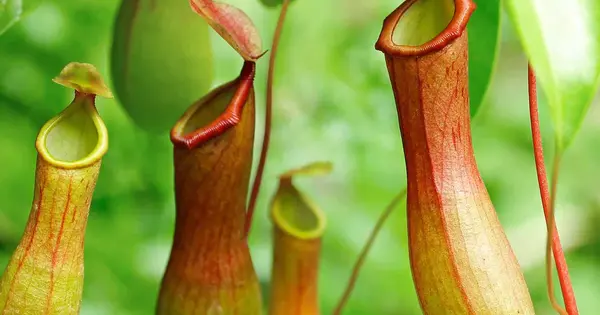Pitcher plants are fascinating carnivorous plants noted for their distinctive pitcher-shaped leaves that serve as traps for insects and other small prey. These are various carnivorous plants with modified leaves known as pitfall traps—a prey-trapping mechanism that includes a deep chamber filled with digesting liquid. These plants are commonly found in nutrient-poor soils, such as bogs, marshes, and other wetland settings, where they have evolved to extract critical nutrients through carnivory. Specialized leaves form the traps of so-called “true” pitcher plants. The plants use nectar to both attract and drown their prey.
The pitcher plant’s unique leaves have a deep cavity filled with liquid, usually a combination of water and digestive enzymes. This liquid attracts insects, who are drawn into the pitcher by nectar released along the rim or walls of the structure. Once inside, downward-pointing hairs and slick surfaces keep the prey from fleeing, forcing them to drown in digesting fluid.
Types of Pitcher Plants
Pitcher plants are classified into various genera, including Nepenthes, Sarracenia, and Darlingtonia, each with distinct traits and environments. Nepenthes species, also known as tropical pitcher plants, are generally found in Southeast Asia, whereas Sarracenia species, or North American pitcher plants, are native to North America.
Pitcher plants are remarkably diverse, with species found all over the world, including North America, South America, Asia, and Australia. Some well-known pitcher plant genera are Nepenthes (tropical pitcher plants), Sarracenia (North American pitcher plants), and Darlingtonia (cobra lily).
Ecological Importance
Pitcher plants play important ecological roles in their habitats. They help control insect populations, particularly in nutrient-poor environments where other plants may struggle to thrive. Additionally, they contribute to nutrient cycling by absorbing nutrients from the decomposed prey.
The plant then absorbs the nutrients released by the decomposing prey, which supplement its diet in environments where traditional soil nutrients are scarce. This adaptation allows pitcher plants to thrive in habitats where other plants struggle to survive.
Conservation
Some pitcher plant species are considered threatened or endangered owing to habitat loss, pollution, and illicit harvesting. Conservation activities are underway to safeguard these plants and their environments, including habitat restoration, captive breeding projects, and public education campaigns.
Pitcher plants have piqued the curiosity of botanists, horticulturists, and hobbyists due to their distinctive adaptations and attractive look. They are commonly maintained as attractive plants and are studied by researchers interested in plant evolution, ecology, and carnivorous plant physiology.
















